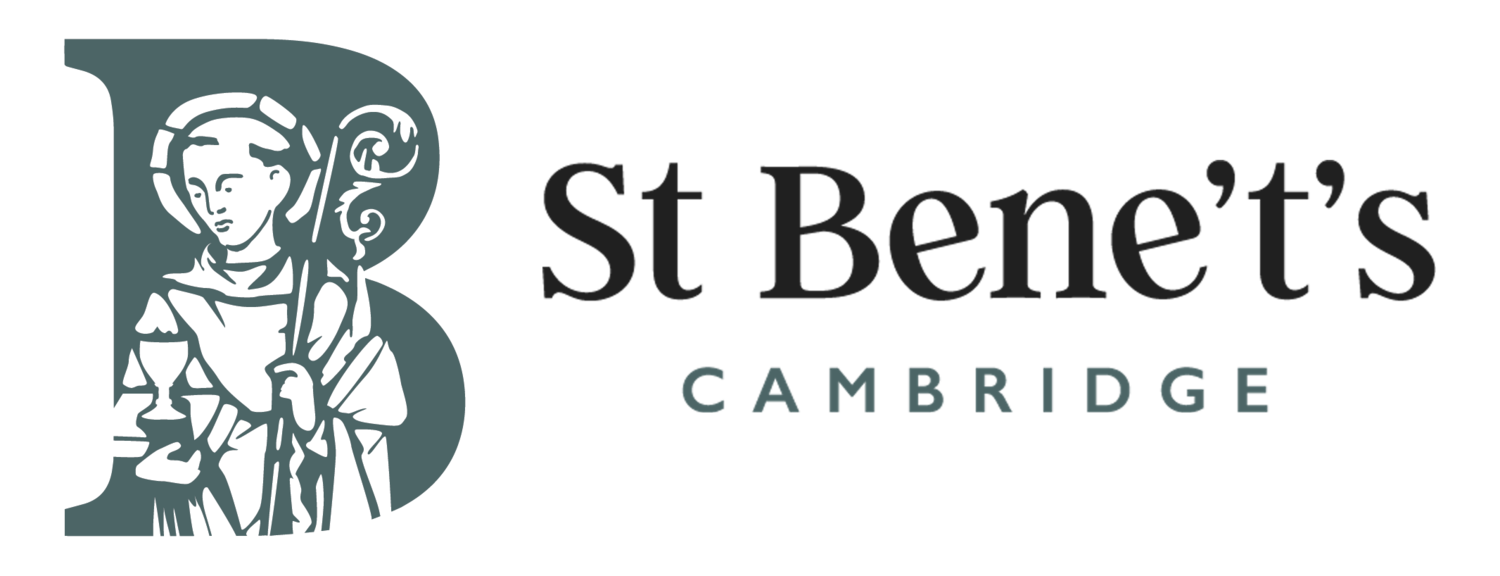St Bene’t’s Stained Glass
By Neil Petersen
There are six windows of stained glass at St Bene’t’s. The east window above the main altar is the largest and is early 20th century and the others are late 19th century. The scenes depicted are taken mostly from St. Luke’s Gospel. This descriptive note begins with the east window above the main altar, then the south aisle windows and finally the tower.
The central panel of the east window depicts Christ blessing the woman who kneels at his feet after she has anointed him with ointment from an alabaster jar. She is drying his feet with her hair (Luke 7:36-50). The side panels show acts of charity: clothing the naked on the left and welcoming strangers on the right (Matthew: 25:31-46). The window is dated 1902, the year of King Edward VII’s coronation; the coronation symbols, the Crown and Sceptre resting on an open Bible, are at the top of the window. The artist is Arthur Savell. The text below the central panel is from St. Luke’s Gospel. The texts below the side panels and in the ribbons held by the angels at the top are from St. Matthew’s Gospel.
The first window in the south aisle has two panels, both depicting the healing of the centurion’s servant (Luke 7:3). The left panel shows the Elders of the Jews asking Jesus to heal the servant. The right panel shows Jesus blessing the centurion for his faith and belief. The glass is dated 1884 and the maker is Ward & Hughes, London. The text below both panels is found in the cited passage in St. Luke’s Gospel whose name is at the top of the window.
The middle window records in two panels the event in St. Luke’s Gospel when Jesus was found in the Temple as described in the banner at the bottom of the window (Luke 2:41-52). His parents are shown at the top right of the scene. The artistic style of these panels is distinctive and different from those in the windows to either side. The date and maker are unrecorded. The texts in the ribbons held by three angels at the top of both panels are from the cited passage in St. Luke’s Gospel. At the top of the window the Greek letters A (Alpha: the Beginning) and O (Omega: the End) are seen.
The third window also has two scenes: in the left panel Jesus reaches out with compassion and blessing to the vulnerable and infirm, with the inscription “Come unto me all ye that are heavy laden” (Matthew 11:28); in the right panel Jesus receives the hospitality of Mary and Martha in their home at Bethany, with the inscription “She has chosen that good part which shall not be taken from her” (Luke 10: 38-52). The glass is dated 1885. The artist is recorded at the bottom of the right panel as “W.H. Constable, Cambridge”. At the top is an angel holding a banner with the words Holy, Holy, Holy (Revelation 4:28).
The window in the tower has three panels recording events in the life of Jesus: nativity on the left (the text is Luke 2:14), baptism on the right (the text is Luke 3:22) and ascension in the centre (the text is John 20:17). The glass is dated 1867 and the artist is W.H. Constable. The scenes are depicted in vibrant colours. Above these three panels are six individual images. There are two angels in the centre, with the four Gospel writers to either side: Matthew and Mark to the left, Luke and John to the right, each rendered as a grey-tinted image against a distinctive blue background. They are of a noticeably different style which suggests that these panels are much older than the rest of the glass in the window. The quatrefoil at the top of the window contains the letters D P F S S representing the Divine Trinity: God (Deus) is Father (Pater), Son (Filius) and Holy Spirit (Spiritus Sancti).
The glass in the opening above the tower arch depicts St. Benedict, the saint in whose name the church is dedicated. The glass is undated. The artist may be W.H. Constable.
Neil Petersen is a barrister and former churchwarden at St Bene’t’s.





